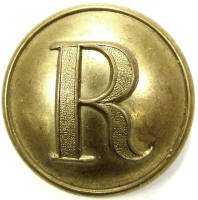
A virtual examination of artifacts of the American Civil War
 | Ridgeway Civil War Research Center,
A virtual examination of artifacts of the American Civil War |
| Civil War Artillery | |
| by Harry Ridgeway |
| Rifled artillery projectile, Britten design, English manufacture, bursting shell, pattern with short tapered nose segmented interior, lead cup sabot, Britten percussion fuze, Blakely rifle 3.5 in. Projectile was manufactured by the English and exported to the American conflict, either side could purchase them, but primary use was southern. The design follows Britten's English patent, employing a lead cup sabot with a counter bulge or large concave teat that extends beyond the bottom. There is a ring around the nose which probably was left from it being clamped to the lathe, American producers tended to use knobs. Interior is segmented to provide points of weakness for maximum fragmentation. It appears that the segmented interior, which is hardened steel, may have initially been manufactured as rolled sheet, then bent into a cylinder forming the core, then an iron skin cast onto the cylinder, the casting is thin on the bottom covered only by the lead cup sabot. Fuze hole is left hand threaded for a Britten percussion fuze, the domed fuze was highly advanced at the time, (Jones, Fuzes, Pg 72). Projectile measures: diameter 3.4in., length 6in. (excluding fuze), weight 11.5lbs. Research Center: Artillery3422-Britten, Ref: Dickey & George, Field Artillery (1993 Edition), pg. 117. Details click: http://relicman.com/artillery/Artillery3422-Britten.html. |
| Ridgeway Civil War Research Center, A virtual examination of artifacts of the American Civil War. Artillery Research center, artillery, click: http://relicman.com/artillery/Artillery0000-Index.html. Research center, artillery, click: http://relicman.com/artillery/Artillery0000-Index.html. |
| Civil War Relicman, Harry Ridgeway, Civil War artillery, Relicman sales catalog. Click here: http://relicman.com/artillery/RelicmanSalesArtillery1.html. Artillery for sale: http://relicman.com/artillery/RelicmanSalesArtillery1.html. |